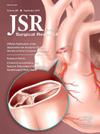在外科手术中使用增强现实技术:一项全面的系统回顾和荟萃分析
IF 1.7
3区 医学
Q2 SURGERY
引用次数: 0
摘要
增强现实(AR)电视有可能彻底改变外科教学和培训。与传统的离体和不带AR的离体相比,本系统综述和荟萃分析试图彻底评估带AR的离体对各种绩效指标的影响,包括任务完成时间、错误率、目标任务特定得分、客观结构化技术技能评估(OSATS)任务特定得分和腹腔镜手术技能评估(GOALS)总体得分。方法于2024年3月对相关数据库进行全面的文献检索,纳入6篇相关文献。为了评估AR对表现指标的影响,进行了荟萃分析,统计分析产生了合并效应大小和95%置信区间(ci)。I2统计量用于评估异质性。结果荟萃分析显示,当将AR与传统方法和不使用AR的方法进行比较时,荟萃分析显示在几个性能参数上有显著的提高。具体而言,任务特异性OSATS得分提高了4.99分(95% CI 0.90至9.08;I2 = 81%),全球OSATS得分提高了1.67分(95% CI 0.57至2.78;I2 = 0%)。此外,goal全球得分上升1.67点(95% CI 0.57至2.78;I2 = 0%),特定任务的goal得分上升1.04点(95% CI 0.25至1.83;I2 = 0%)。值得注意的是,当使用AR时,作业完成时间的平均差异为- 10.99 (95% CI -34.07至56.05;I2 = 68%)。然而,错误率没有明显下降(平均差异:−18.92,95% CI−57.93至20.08;I2 = 85%)。任务特异性OSATS得分(P = 0.003)和任务完成时间(P = 0.02)存在异质性。综上所述,本系统综述和荟萃分析强有力的证据表明,增强现实技术可以改善手术训练结果。这项技术具有彻底改变外科教育的潜力,正如所观察到的目标和OSATS任务特定分数的显着提高以及任务完成时间的大幅缩短所看到的那样。为了解决观察到的差异并调查影响表现结果的其他因素,如学习曲线和长期技能保留,需要进行更多的研究。本文章由计算机程序翻译,如有差异,请以英文原文为准。
Telestration With Augmented Reality in Surgery: A Comprehensive Systematic Review and Meta-analysis
Introduction
Augmented reality (AR) telestration has the potential to completely transform surgical teaching and training. In contrast to traditional telestration and telestration without AR, this systematic review and meta-analysis attempted to thoroughly assess the effect of telestration with AR on a variety of performance metrics, including task completion time, error rates, GOALS task-specific scores, Objective Structured Assessments of Technical Skills (OSATS) task-specific scores, and Global Operative Assessment of Laparoscopic Skills (GOALS) global scores.
Methods
Six relevant publications were included after a thorough literature search was carried out on March 2024 across relevant databases. To evaluate the impact of telestration with AR on performance indicators, meta-analyses were carried out, and statistical analysis produced pooled effect sizes and 95% confidence intervals (CIs). The I2 statistic was used to assess heterogeneity.
Results
The meta-analysis showed that when comparing telestration with AR to traditional approaches and without AR, the meta-analysis showed significant gains across several performance parameters. In particular, there was an improvement of 4.99 points (95% CI 0.90 to 9.08; I2 = 81%) in the task-specific OSATS scores and 1.67 points (95% CI 0.57 to 2.78; I2 = 0%) in the Global OSATS scores. Moreover, there was a 1.67 point (95% CI 0.57 to 2.78; I2 = 0%) rise in GOALS Global scores and 1.04 points (95% CI 0.25 to 1.83; I2 = 0%) in the task-specific GOALS scores. Notably, a mean difference of −10.99 (95% CI -34.07 to 56.05; I2 = 68%) was seen in the job completion time when telestration with AR was used. Error rates, however, showed no discernible decrease (mean difference: −18.92, 95% CI −57.93 to 20.08; I2 = 85%). Heterogeneity was explained in task-specific OSATS scores (P = 0.003) and task completion time (P = 0.02).
Conclusions
In conclusion, there is strong evidence from this systematic review and meta-analysis to suggest that telestration with augmented reality can improve surgical training outcomes. The technology has the potential to completely transform surgical education, as seen by the notable gains in task-specific scores for both GOALS and OSATS that have been observed, together with the large reductions in task completion times. To address the observed variation and investigate other factors influencing performance results, such as learning curves and long-term skill retention, more research is necessary.
求助全文
通过发布文献求助,成功后即可免费获取论文全文。
去求助
来源期刊
CiteScore
3.90
自引率
4.50%
发文量
627
审稿时长
138 days
期刊介绍:
The Journal of Surgical Research: Clinical and Laboratory Investigation publishes original articles concerned with clinical and laboratory investigations relevant to surgical practice and teaching. The journal emphasizes reports of clinical investigations or fundamental research bearing directly on surgical management that will be of general interest to a broad range of surgeons and surgical researchers. The articles presented need not have been the products of surgeons or of surgical laboratories.
The Journal of Surgical Research also features review articles and special articles relating to educational, research, or social issues of interest to the academic surgical community.

 求助内容:
求助内容: 应助结果提醒方式:
应助结果提醒方式:


